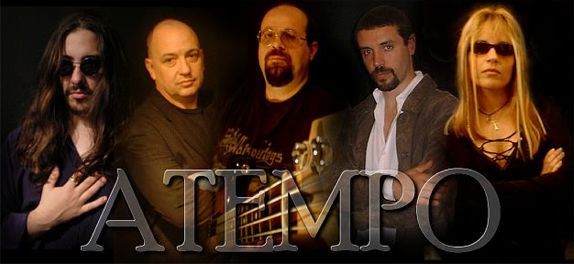
Hiro - Eduardo Aguirre - Pablo Villanueva - Claudio Fazio - Mariela Gonzalez
click on image to visit artist's website
Abismos del Tiempo (Abysses of Time)
album review and exclusive interview with
vocalist Mariela Gonzalez
review, interview and HTML © Russell W. Elliot 2003
all images used with permission
Formatted for 800 x 600 or larger windows
Last updated: 23 July 2003
Sometimes seemingly mysterious albums sent to us for review out of the clear blue strike our editors with complete awe from first listen. Such was the case when we first played the debut album from ATempo, an emerging band from Argentina. Without any fanfare, we began to listen to Abismos del Tiempo and immediately recognised Mariela Gonzalez when the lead vocal part began. A quick flick through the liner notes confirmed she was indeed the band's lead vocalist. What a find! Some will recall that Mariela was the voice of Nexus on their two albums Detrás del Umbral and Metanoia (review). We first met at NEARfest in 1999 and have corresponded since. Personally responsible for sending us the new ATempo album, she readily accepted our invitation for an interview and provided the photographs we have included within this feature article.
Mariela joined ATempo as a full time member during the final creation and production of Abismos del Tiempo. Initially invited to participate in the debut album as a guest, she was rapidly accepted by the band members and her inputs assimilated into the project during the creative process. The result is an album with substantially more female lead and backing vocal content than Mariela's recordings with Nexus. The ATempo lineup is completed by Pablo Villanueva (bass), Claudio Fazio (drums), Eduardo Aguirre (acoustic and electric guitars), Hiro (piano and keyboards) and backing singers Sofía Uzal, Paula Uzal and Umi Romeo, conducted by Mariela Gonzalez. Fabian Fazio (flute, clarinet) was invited as a guest for the project. Read more about the band in our exclusive Mariela Gonzalez interview and learn more about their incredible album in our review. The English translation of our interview has thankfully lost neither the texture nor the the heartfelt emotion expressed in her native tongue when responding to our questions.
Review
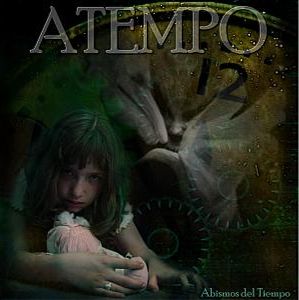 Image © Gosolf Art & Design 2003 |
Abismos del Tiempo (Record Runner (Argentina) RR0400, 2003) is a collection of twelve individual tracks but there are really only four songs per se. The album opens with a powerful progressive epic entitled "Héroe de la Soledad" and is followed by "Lluvia Mística" and stunning accessible showcase number "Cárcel de Sueños." The multi-part suite "El Final"--running almost 48 minutes and spread across eight tracks on the CD counter--concludes the album. The backing singers contribute chorus parts working individually and as a choir adding texture and extending Mariela's powerful mid-range lead vocal.
The layers of vocal work on Abismos del Tiempo pull the listener in from the opening track. Mariela's serious, powerful and evocative lead vocal glides atop the layers of backing singers and rich progressive instrumentation in the opening epic "Héroe de la Soledad" (Hero Of Loneliness) running 11:21. Small male spoken parts, also in Spanish, crisp percussion and multiple instrumental passeges incorporating soaring guitar excursions, contribute to the progressively edged metal power of the track.
Listeners are reminded that this is a concept album. From the liner notes, "How to return from the most distant dreams, if the souls don't want to return from the Abysses of Time., We are kings of our fates but only ashes if our heart darkens under the robe of the immediate success. The life blinks and we are dissolved in our timeline without be[ing] aware the Love Dies To Our Side." The dark texture of the accompanying booklet seems to perfectly complement the lyrical themes. Although the material is sung entirely in Spanish, the lyrics are provided in both Spanish and English.
The album's second track "Lluvia Mistica" (Mystical Rain) is a brighter and more orchestrally arranged number, heavily influenced by new age-styled keyboards to producee a progressive sounding ballad. Mariela's lead is sweeter, sung in a higher register initially, clearly demonstrating the extensive range of her well developed voice. Backing vocals swirl in the background providing additional texture to the theme. Ripping guitar solos and Mariela's soaring vocalise in the latter half of the song stand out superbly.
Although sometimes difficult to mention in epic progressive albums, clearly "Cárcel de Sueños" (Jail Of Dreams) is the standout track. It opens with the sound of a gentle ballad, Mariela's tender voice singing atop acoustic guitar for one verse. By the second verse, bass guitar joins in and emotion builds in Mariela's lead vocal. But then the entire band takes hold and Mariela is in full form, especially in the robust chorus. In the remaining verse / chorus passages one hears ATempo at their absolute best. The acoustic guitar solo in the bridge perfectly compliments the track which concludes with an all out progressively styled rocker, Mariela soaring atop the lush arrangement in the final chorus.
 Image © Gosolf Art & Design 2003 |
The nine 'act' "El Final," a 47:20 suite that concludes the album is indeed a progressive masterpiece. Opening with "Voces" (Voices), one will hear the fantastic vocal performances of the backing singers as arranged by Mariela herself. While light instrumentation initially punctuates this serious introduction, the progressive power of the band and their thick electric guitars let go by the end of the track. "La Poco que Queda de mi Corazón" (The Last Part That Reamin Of My Heart) is sung evocatively atop piano alone initially. Vocals build in power as robust electric and acoustic guitar solos, crisp percussion and rhythmic bass unfold in this powerful piece. We especially enjoyed the choir like keyboard textures in the bridges, the vast excursions of their solos and the metal edginess in the electric guitar solos. The energetic flute solo work awe inspiring and provides the perfect track.
The texture changes entirely in "Lamentos" (Sadness), a progressive ballad evocatively sung solo by Mariela and principally backed by simple by piano and clarinet. It is here that one will hear Mariela's voice in its most pure form without excessive effects, instrumentation or layering. The stunning instrumental conclusion to the track features soaring guitar and keyboard solos. And in perfect symphonic progressive style, the robust conclusion of the previous track blends into "Sincio de Otono" (Autumn Silence), whose rich arrangements continue to develop the theme. Mariela's vocals take on a new seriousness with the thick electric arrangements but adapt in the quieter movements within the piece.
"Requiem" is a rhythmic instrumentally-oriented piece. A short drum and bass solo are placed midway before the brighter cinematically styled keyboard passages join with flute and clarinet to return to the main progressively styled theme of the tune. One more ballad follows as the album moves towards its conclusion entitled "Recuerdos" (Memories). Mariela delicately sings initially atop gentle piano before the electronic instrumentation builds as the track concludes. Be sure to listen for the sweet layers of backing vocals at the edges. We especially enjoyed the lush keyboard instrumentals in "Sinfonia Azul" (Blue Symphony) and guitar work within it as well. "El Final" (The End) is concludes the number with a brief soaring vocal passage that follows a symphonic instrumental while "La Ruina del Honor" (The Runs Of The Honor) is a gentle postlude with a well arranged choir of backing vocals that brings the album to an incredible conclusion.
Aside from Mariela Gonzalez' stunning vocal contributions, ATempo's Abismos del Tiempo is truly a progressive masterpiece. We give the album our highest recommendation. Available through online resources and international progressive rock CD retailers , it is worth a trans-Atlantic journey. Accordingly it is a must listen!
Interview
Musical Discoveries: Are you a full-time member of ATempo or are you a guest artist?
Mariela Gonzalez: I would like to be very clear on this point, since still there are people that don't know that I have left Nexus. At the beginning ATempo was a project in which I collaborated as invited for its first CD Abysses of Time, due to after listening the material, I found a good challenge that they proposed me. Now, after a little more than one year, I can tell you that our relationship has been really very good and that everything was flowing very naturally, so today I can confirm to you that I am a member full time of ATempo.
 Image © Gosolf Art & Design 2003 |
How did you hook up with ATempo? Please tell us the story.
In fact Claudio Fazio--ATempo's drummer--was who sent me a letter to propose the invitation. I remember the sensation that I had when I listened the material, it was really very strong, because it could gave me the possibility to show something more than what was previously known about me.
The idea was to participate in the production, mainly in all that refers to the voice. Although there was an idea of what was wanted, it was really incredible, because the boys trusted in me and they allowed me to do my job in total freedom.
I had only six months before the recording but anyway, I worked very much on each song and I think I achieved what I wanted that was to respect the concept of the piece and the person that composed it and same time, to give to Abysses of Time, all that I believed that it should have.
What about your background before Nexus and then the time between Metanoia and the newest ATempo album.
Before working with Nexus, I was dedicated almost completely to my vocal technique studies. I had a very demanding professor as my intention was to pass the entrance exam to the Colon Theater School--here in Buenos Aires--to study lyrical song. Although the opera is something that I like very much, I could not fulfill this dream. I had a full time job and regrettably, I couldn't leave it to attend the school five hours per day.
Anyway, I continued studying and the fate crossed my road with the band Nexus. At that time, I had to learn everything about symphonic genre and after a time, I decided to change professors. I began to work with Jorge Diez (Studio Producciones - Argentina). He really knows the genre and he had developed a vocal technique, more oriented to what I was starting.
I was also part of a hard rock band for some time. My influences are well defined, I like hard rock music very much and I think it is the gender that more I listen. We never recorded any material, but it was a very good experience. Besides working in the composition of the songs with the other band members, I learned a lot about rock's aesthetics and what is expected from a band on stage.
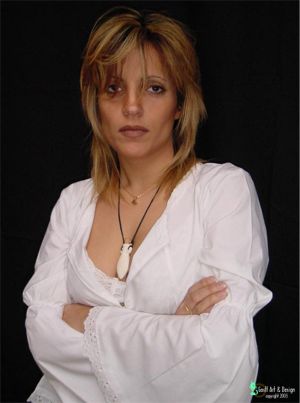 Image © Gosolf Art & Design 2003 |
Today I think I am a mixture of all that and I really enjoy it. I would tell you from the beginning of my career, I was in three bands--included ATempo--which have occupied all my time. In my country it is very difficult to combine the music with your daily life. If you are dedicated to the music, you still have to work outside the industry to live and sometimes it is very difficult.
Regarding the future, the possibility exists to do a solo project, in parallel with my work in ATempo, but still it will be a while before this becomes a reality.
What happened with Nexus?
I was in Nexus from 1990 until end of 2001. I really had a very good and productive period. It was time where I cultivated fruits and important achievements in my musical career. But I also think that musicians finish periods and we have times where we have the needs to grow from inside. That is the time where changes and turns are necessarily taken. You feel with desires to explore new directions and to dare to commit roles with more responsibilities. Based on this I think my time in Nexus is a fulfilled period.
Today they are presenting their material with new vocalists and I'm working with the new material for the second ATempo CD.
Please tell us all about ATempo. What are the plans for the band?
ATempo is a band where the respect is central, first toward us and toward our inside, then for the final listener of our proposal and for those that spread our project.
Regarding band's plans for this year I could tell you that we will start in Argentina on July 03, doing the official presentation of the CD in an exclusive show for press and some fans. Then we will continue presenting the whole material and closing the year in one of the most important theaters in Buenos Aires. Meantime, we haven't discarded the possibility to travel to present Abysses of Times inside of our country.
 Image © Gosolf Art & Design 2003 |
We are also evaluating what concrete possibilities are to presenting the material outside the country, but as you should already know, the economic situation that we are crossing nowadays in our country, made it more difficult to fulfill.
Who are your favorite artists/bands?
The music that I listen is quite different, but mainly Pink Floyd, Marillon, Genesis, Queen, Yes, Arena, Lorena McKennitt, Lissa Gerard, Dream Theater, Symphony X, Landmarq, Quidam, Deep Purple, Whitesnake, Iron Maiden, Sad Whisperings, Rhapsody, Blind Guardian etc. But I also listen more frequently to opera and a little of gothic music.
How did you develop your vocal style?
I developed my vocal technique with Jorge Diez (Studio Producciones - Argentina), starting from a system that had origins in Hungary before the second world war. In the Budapest conservatory, musicians like Bela Bartok and Zoltan Kodaly created an especially suitable vocal technique to sing camera music in German and Slavic languages. Departing from this base, Jorge mixed that technique with elements from the European school and he adapted it especially to sing rock. This technique extends your registration to the maximum and it doesn't color your voice, it does mean that it doesn't sound operatic no matter how much you use a hundred percent of placement, it always sounds as your natural voice.
Regarding the scenic performance, I worked with Jorge on theatrical techniques--he has a big influence from Grotowski--and we finished arming each CD song from a perfectly defined character that allows me to achieve an enormous variety of shades. Even more, as when I made the recording I was with serious problems of health, I used the corporal pain as inputs and each song finished having a center of gravity from where it more claimed me at the moment that we worked on it. The important thing about this way of working, is that you are neither thinking about the movements nor the choreographies, but you use the elements as triggers and at showtime it makes you move an arm, move yourself, or to express a certain sentence in one way or another.
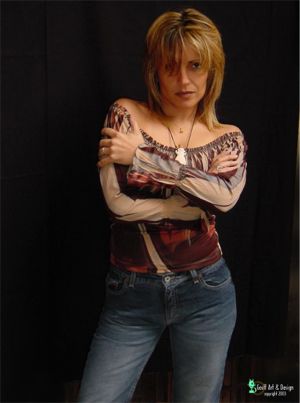 Image © Gosolf Art & Design 2003 |
What artists to you feel have influenced your music over time?
In the beginning I had as reference, mainly David Coverdale (Whitesnake) and Ann Wilson (Heart), but as time went on my influences came from Lissa Gerard, Freddie Mercury, Fish or Peter Gabriel, they are who I identify myself.
And how about Annie Haslam and Renaissance?
I don't have anything visual from Annie Haslam, just some pictures, and some people told me a lot about her. I just have listened to her on CD, and that was enough for me to realize that she is a reference for any woman that sings in this genre and that she is really very talented. Maybe one day I will achieve one of my dreams, that is, to meet her.
What else did you do on the Atempo album?
In ATempo I contributed in the production and vocal arrangement of the pieces, since when I entered to the band all the material was almost composed. On one hand I had to change the whole history to be sung by a woman, as it was written to be sung by a man, all of this without changing the concept. As the lyrics of the songs have a big emotional load, I worked from each character's interpretation.
It was a very complex job, because I had to make the interpretation and at the same time not to leave aside the melodic lines. I also worked in the composition and arrangement of the choirs, voices that also had to get quality and a certain load of feelings when being represented.
Please explain the creative process in the music you have recorded.
Abysses of Time is a conceptual album, even considering that it has three isolated songs and a suite. The concept of the material and the main theme of the lyrics are centered in the vision of the human feelings from an inside perspective. Starting to rehearse the material was a very hard job because the songs were composed to be interpreted by a man. From the beginning, when I listened the whole material I decided to take the responsibility and the challenge to do the vocal production of the piece.
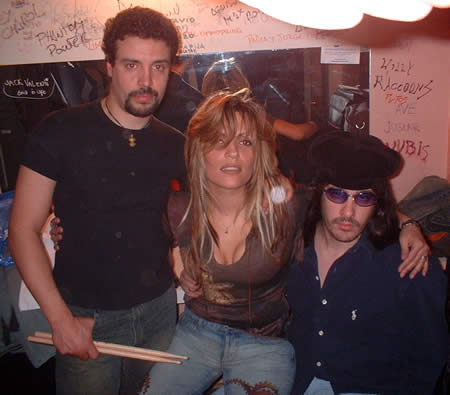 Claudio Fazio, Mariela Gonzalez, Hiro Cavern Press Show, Buenos Aires, July 03, 2003 Image © Gosolf Art & Design 2003 |
Although the lyrical part was already composed when I joined the project, Abysses of Time has a difficult vocal line because the compositions have a big emotional load and for that reason we worked very hard in the interpretation of the histories.
I should add that the musicians trusted fully in me and although they were to my side while I did the vocal part of the songs, they gave me total freedom when I had to take the final decision for the parts that would be in the CD.
Do you have a career or work outside music?
I work as consultant in Financial Systems for Bank Operation. On the other hand I am starting to open a business with my own brand, for sale of regional articles of my country. I'm very busy with this project lately.
Do you plan any additional live performances or video?
With ATempo we have planned to begin to film near end of this year, but we didn't confirm it yet, it is a project that it is just starting to mature.
 Umi Romeo and Mariela Gonzalez Cavern Press Show, Buenos Aires, July 03, 2003 Image © Gosolf Art & Design 2003 |
What are your plans for 2003?
Just to be dedicating to show the material of Abysses of Time with the band, in the country and outside of it.
Is there another ATempo album in the works or some other material you have done that people should know about?
With Nexus we recorded an unpublished song some years ago called "Aurora." It is an autochthonous song dedicated to the flag of my country. Very recently, with ATempo, we recorded an extra song, by order. It is called "Cinthya" and it will be included in a childish videoclip.
How has the internet influenced your musical career and the promotion of your music?
The internet opened me the doors to the world. It means many more people can learn about my work. I think actually it is one of the more important communication tools. In fact ATempo has its own website and I, same as each of the musicians, have my personal page there.
Return to website contents